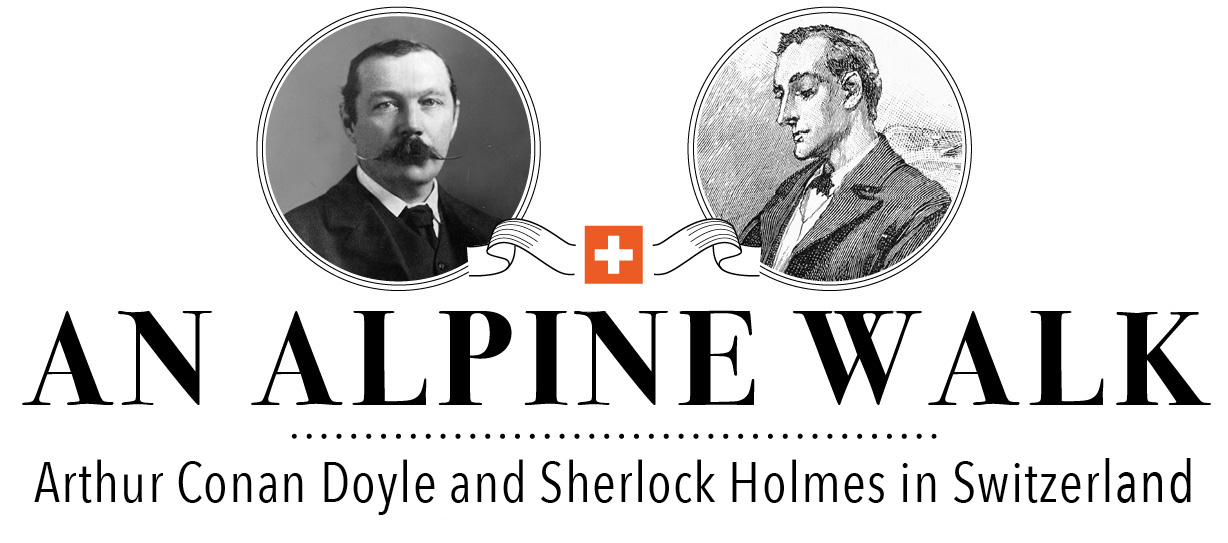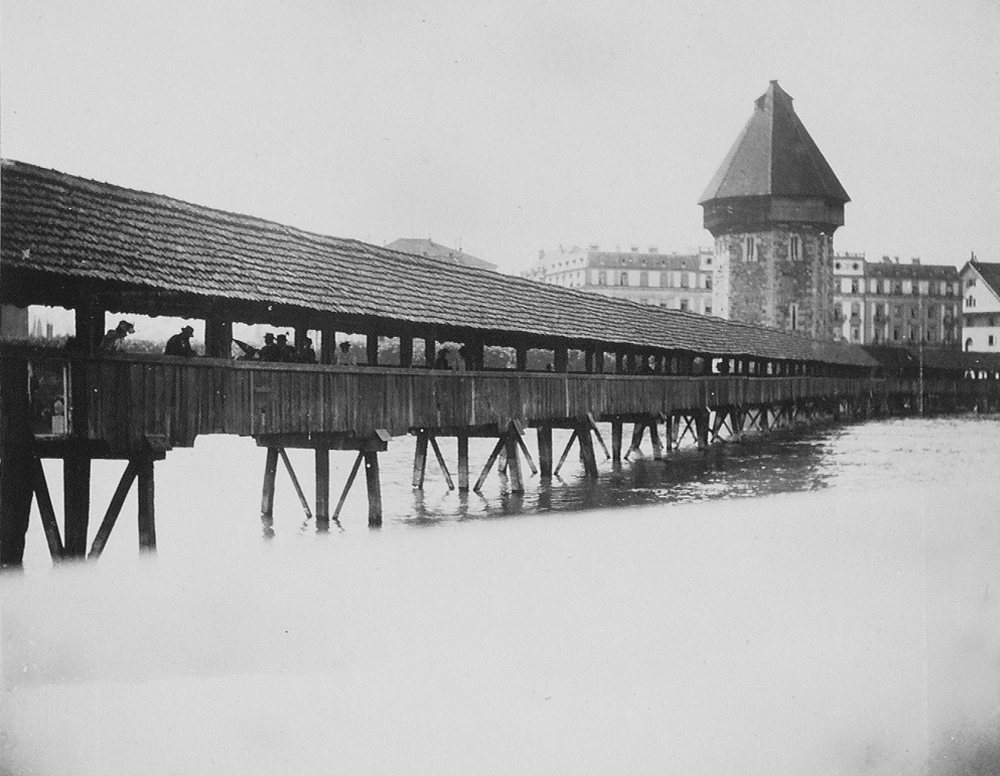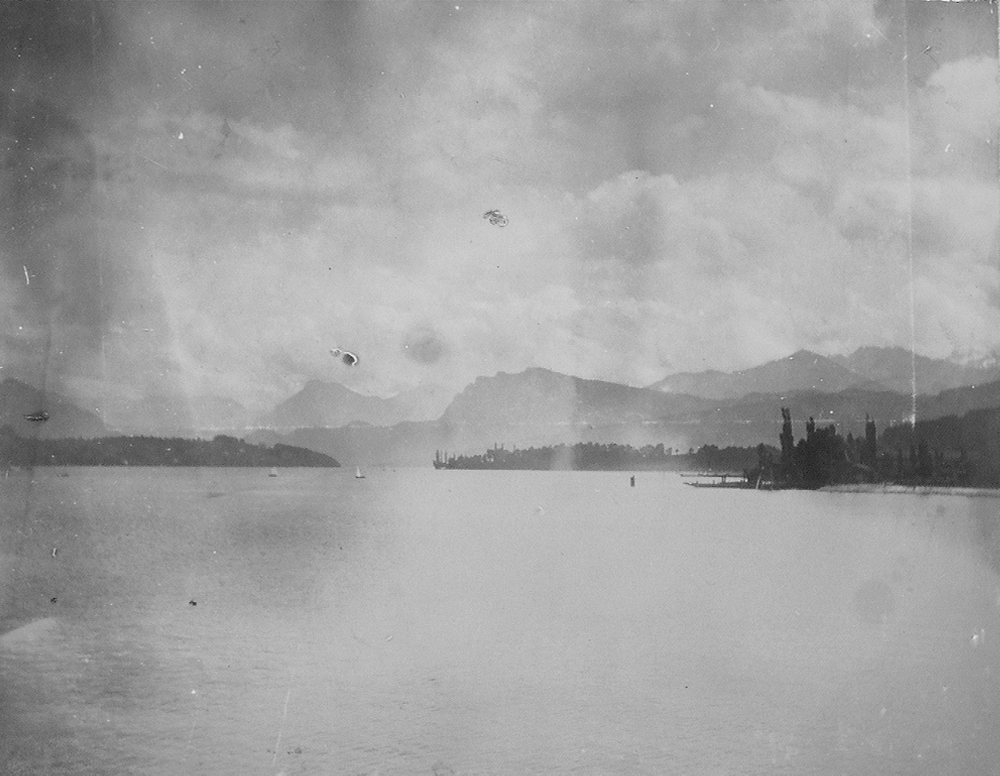From Lucerne to Zermatt
During the summer of 1893, Arthur Conan Doyle travels to Lucerne in order to give a lecture on literature. At this time, the author has already published many short stories and several novels, such as Micah Clarke, The Firm of Girdlestone and The White Company. But he is mostly known to the public for having created the character of Sherlock Holmes, especially since the detective’s adventures have been appearing as short stories in The Strand Magazine since 1891. The talk Conan Doyle has to give in Switzerland, however, does not concern his own literary creation but that of other British contemporary writers of fiction.
“Ancient Bridge of Lucerne”
The Chapel Bridge in Lucerne ([1893]).
(BCU-Lausanne, IS 4314/5/1/3)
“Bullock cart” ([1893])
(BCU-Lausanne, IS 4314/5/1/3)
“Lake of Lucerne” ([1893])
(BCU-Lausanne, IS 4314/5/1/3)
A lecture given by Arthur Conan Doyle
In August 1893, the British writer and his wife Louise go to Lucerne, where the creator of Sherlock Holmes has been invited to take part in a series of lectures (“Young People’s Fortnight”) organized by the editors of the magazine The Young Man. Asked to express his opinion on the literature produced by his British contemporaries, Conan Doyle gathers an audience of more than 400 people at Christ Church on the 9th of August.
Reviews of his lecture, entitled “Fiction as part of Literature”, will appear in a few British and American newspapers, and it will be noted that, unlike some critics who tended to disparage contemporary authors in comparison with the great writers of past generations, Conan Doyle endeavours to present a positive and confident view of the works of British writers of his time. Among those he speaks about are Robert Louis Stevenson, James Matthew (J.M.) Barrie and Rudyard Kipling, with all of whom he is or will be acquainted.
During the few days they spend in Lucerne, the Doyles reside at the Hôtel de l’Europe, an institution situated close to the lake. Arthur Conan Doyle takes some pictures of the city, notably of the famous Kappellbrücke, and enjoys regular swims in the lake. Staying at the same hotel as the Doyles, whom he meets and befriends, is Silas K. Hocking, a Methodist preacher and – at the time – a famous writer, who also takes part in the cycle of lectures. It is mostly thanks to his recollections of that 1893 trip to Switzerland that we have some details about Conan Doyle’s visit that summer. Indeed, if Conan Doyle, in his autobiography Memories and Adventures does not dwell at length on this Swiss interlude, Silas Hocking, both in an article for the magazine The New Age (“A Holiday with Conan Doyle”, 1895) and, later, his autobiography (My Book of Memory, 1923), writes about his meeting and occasional travels with Conan Doyle that summer.
“ We talk about the delights of a swim in the lake. At least he did. For he had been in Lucerne several days, and once each day, at least, had courted its cool embrace. ”
Silas Hocking, “A Holiday with Conan Doyle”, The New Age, 24 February 1895
“ Here are real blue mountains, and as we saw it on arriving two hours ago, real blue sky and water. ”
Extract of a letter from Richard Doyle after a transcript (BCU-Lausanne, IS 4314/3/1/2)
Arthur Conan Doyle is not the first member of his family to stay in Lucerne. His uncle Richard (1824-1883), a renowned illustrator who notably worked for the magazine Punch, also visited the city in the 1850’s. The Swiss scenery seems to have impressed the artist, as can be seen in the transcript of a letter – unfinished and undated – written from his room at the “Schweitzer Hof Hotel” (Schweizerhof) to an unidentified recipient (probably his sister Annette or brother Charles) :
“ This is a sight ! The Lake of Lucerne !! I am sitting in a bedroom writing, and looking out of [the] window alternately at one of the most beautiful views that can be concieved. We are on the very edge of the Lake, and are surrounded by Mountains, the moon is shining on the water, picturesque towers and churches rise here and there, the celebrated Regi [sic] is over the way immediately, and an awful mountain of singularly wild and rugged appearance – Monti Pilata, where Pontius Pilate is said to have drowned himself in a lake at the summit – rises on the right-hand side. The beauty of this whole business overwhelms me with feelings of joy and wonder, and I feel as if I must sit down here and defy Nature (or any other person) to bring or produce any landscape or view that could put the nose of this landscape or view out of joint. Hurrah ! I have not lived in vain. Here are real blue mountains, and as we saw it on arriving two hours ago, real blue sky and water. This is the seat of the exploits of William Tell. Tomorrow morning at four o’clock we start by steamboat up the Lake, en route for the Alps, and we will see the sun rise upon the Lake. ”
Extract of a letter from Richard Doyle after a transcript (BCU-Lausanne, IS 4314/3/1/2)
The Schweizerhof, in Lucerne, where Richard Doyle stayed in the 1850’s. Engraving from Souvenirs du Righi, Henry Fuessli & Co., Zürich ([after 1836]) (Bibliothèque nationale suisse, nbdig-18824)
Brown, Jones et Robinson
The Foreign Tour of Messrs Brown, Jones and Robinson : being the story of what they saw and did in Belgium, Germany, Italy and Switzerland (Richard Doyle, 1854)
Also in the 1850’s Richard Doyle publishes The Foreign Tour of Messrs Brown, Jones and Robinson : being the story of what they saw and did in Belgium, Germany, Switzerland & Italy, a humorous book illustrating the journey of three friends who, like its author, also visit Lucerne.
The call of the mountains
“The Matterhorn” ([1893])
(BCU-Lausanne, IS 4314/5/1/3)
After enjoying the city of Lucerne, the Doyles continue their visit to Switzerland, heading south to Meiringen, crossing the Grosse Scheidegg and then the Gemmi pass to join the Rhône valley, en route to Zermatt.
To reach Zermatt, the Doyles can travel by train, using the Viège-Zermatt line, completed only two years before, in 1891. As with other small mountain villages, rail helps in developing Zermatt, since the place is now more accessible to tourists, who benefit from the growth in the number of hotels in the Walliser resort since the 1850’s. One man who contributed to making Zermatt a fitting place to host mountaineering enthusiasts is Alexander Seiler, who created several hotels, such as the luxurious Riffelalp, where Arthur and Louise Conan Doyle stay in 1893. Located at more than 2200 meters above sea level, the building commands a direct view of the Matterhorn.
“A wayside halt”
Silas Hocking (in the middle) sitting on the side of a path ([1893]). (BCU-Lausanne, IS 4314/5/1/3)
“Riffelhaus Hotel (in an earthquake)”
The Riffelalp hotel, in Zermatt ([1893]).
(BCU-Lausanne, IS 4314/5/1/3)
On their way to Zermatt, the Doyles again meet Silas Hocking who is heading to the same place and, as in Lucerne, staying at the same hotel. He will later say that Arthur Conan Doyle always kept his Kodak camera handy and took pictures every day. Doyle does indeed have his camera with him when he makes a trip to the Findelen glacier, one of the biggest in the region east of Zermatt, with Silas Hocking and E. F. Benson (son of the archbishop of Canterbury), who also stayed at the Riffelalp. At the end of August, Arthur Conan Doyle and his wife return to England.
“Glacier”
The Findelen glacier ([1893]). (BCU-Lausanne, IS 4314/5/1/3)
“ What a delightful week we spent on this glorious eminence, with the lonely peak of the Matterhorn towering thouands of feet above us still, and the strangely impressive glaciers almost completely encircling us. ”
Silas Hocking, “A Holiday with Conan Doyle”, The New Age, 24 February 1895
Conquest of the Findelen glacier
“Glacier in Twilight” ([1893])
(BCU-Lausanne, IS 4314/5/1/3)
“The Monarch of the Glacier” ([1893])
(BCU-Lausanne, IS 4314/5/1/3)
“An Untrodden Peak” ([1893])
(BCU-Lausanne, IS 4314/5/1/3)
A story
never written
“On the Gemmi Pass”
Arthur Conan Doyle and a guide on the Gemmi Pass ([1893]).
(BCU-Lausanne, IS 4314/5/1/3)
In Through the Magic Door – an essay about his favourite writers published in book form in 1907 – Arthur Conan Doyle recounts an anecdote from his travels through the Gemmi Pass. Arriving at the summit of the pass and having halted at an inn, he was impressed by the solitude of the place, which, he was told, was completely isolated in the heart of winter. The writer then devised the plot of a story in which a group of travellers are crossing the same pass and, stopped by the snow, have to seek refuge in a cabin, where their mutual resentments, the isolation and the impossibility of escaping each other’s presence lead to nefarious consequences. However, a few weeks later, Conan Doyle, reading by chance a book of short stories by Guy de Maupassant, comes across the story L’Auberge (“The Inn”), also inspired by the Gemmi Pass and having a very similar scenario. Doyle, relieved that he had avoided unknowingly reusing an idea already exploited by another author, will never write the story.
“Gemmi Pass from below” ([1893])
(BCU-Lausanne, IS 4314/5/1/3)
“Glacier from Gemmi” ([1893])
(BCU-Lausanne, IS 4314/5/1/3)
“Landlady looking for travellers”
The Schwarenbach inn on the Gemmi Pass ([1893]). (BCU-Lausanne, IS 4314/5/1/3)
During this Swiss trip, a place visited by Arthur Conan Doyle will stimulate the writer’s imagination and, in doing so, play a vital part in the outcome of a story which will astound the readers of the adventures of Sherlock Holmes.
At the time of Conan Doyle’s visit to Switzerland in 1893 the Reichenbach falls, near the village of Meiringen in the Bernese Oberland, are already a famous tourist spot, and the writer does not fail to visit the place. The funicular is not yet in existence, for it will be inaugurated in six years’ time, in 1899, allowing visitors to reach directly the top of the falls at a height of more than 100 meters. The path that Conan Doyle now follows will be the same one which Sherlock Holmes and Doctor Watson will tread in the short story The Adventure of the Final Problem, written in this same year. For the author, this will just be a pleasant excursion, but for the detective and his faithful friend, the consequences will be more tragic, for it is there that Sherlock Holmes will disappear.

“ It was upon the 3rd of May that we reached the little village of Meiringen, where we put up at the Englischer Hof, then kept by Peter Steiler the elder. Our landlord was an intelligent man, and spoke excellent English, having served for three years as waiter at the Grosvenor Hotel in London. At his advice, upon the afternoon of the 4th we set off together with the intention of crossing the hills and spending the night at the hamlet of Rosenlaui. We had strict injunctions, however, on no account to pass the falls of Reichenbach, which are about half-way up the hill, without making a small detour to see them. ”
Arthur Conan Doyle, The Adventure of the Final Problem (1893)
Next chapter (2/6) →
← Home






















